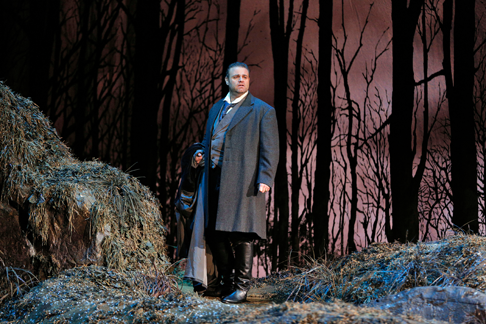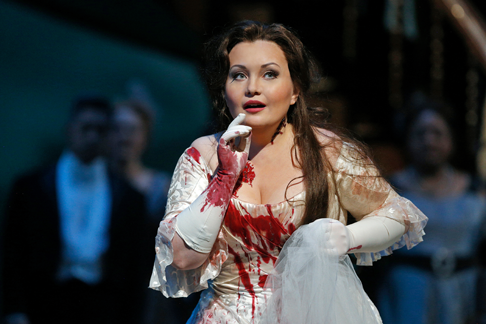03 Apr 2015
The Met’s Lucia di Lammermoor
Mary Zimmerman’s still-fresh production is made fresher still by Shagimuratova’s glimmering voice, but the acting disappoints

Mary Zimmerman’s still-fresh production is made fresher still by Shagimuratova’s glimmering voice, but the acting disappoints
There’s lots of life left in Mary Zimmerman’s handsomely staged and remarkably fresh Metropolitan Opera production of Lucia di Lammermoor, which debuted in 2007 with Natalie Dessay in the title role and has been reprised here several times since.
There’s lots of life, too, in the voice of Albina Shagimuratova — the title character in the company’s 2015 reprisal that opened March 16.
From a purely visual perspective, Shagimuratova may not get everyone’s vote for the most persuasive Lucia to have populated a Zimmerman production — which besides Dessay has included Annick Massis, Diana Damrau and Anna Netrebko. Nor is Shagimuratova likely to win any awards for best actor. But if the Russian soprano does not entirely look the part of the fragile vulnerable tragic heroine, she sure does sound it. Of the three Zimmerman Lucias I’ve heard to-date (Dessay, Netrebko and Shagimuratova), none has surpassed the sheer beauty and agility of the latter’s dramatic coloratura soprano.
Donizetti's opera, a perennial favorite since its Neapolitan premiere in 1835, is loosely based on Walter Scott’s The Bride of Lammermoor — the historical novelist's 1819 tale of a feuding pair of Scottish noble families, the Ravenswoods and the Lammermoors. (Zimmerman moves the setting a couple of hundred years forward to the Victorian Era.)
 Joseph Calleja as Edgardo
Joseph Calleja as Edgardo
Lucia, utterly dominated by her manipulative brother Enrico (Luca Salsi), is forced to agree to an arranged marriage with Arturo (Matthew Plenk) — a wealthy nobleman with good political connections. Enrico is counting on Arturo to rescue him from financial ruin. Lucia, however, loves Edgardo (a Ravenswood, played by Joseph Calleja) and understandably keeps her ongoing rendezvous with her lover secret. When Enrico forges a letter to convince Lucia that Edgardo has abandoned her, the brokenhearted woman reluctantly agrees to the arranged marriage. Later, when Arturo takes his new bride to the bridal bedroom as the wedding guests party downstairs, Lucia goes mad and fatally stabs her new husband. Doused in blood and in the throes of vivid hallucinations, she sings the iconic Mad Scene.
The role of Lucia (Lucy Ashton in Scott's novel) demands more from the voice than Italian bel canto beauty of timbre to pull it off. The singer must have strength, stamina and a dependable top range (Donizetti wrote high Fs, though it’s customary for singers nowadays to transpose down to a more manageable E-flat).
Vocally, Shagimuratova has it all — as could be seen early on during the scene at the fountain in the woods outside Ravenswood Castle. Her delicate delivery and superb intonation in her opening numbers (Regnava nel silenzio and the Quando rapita in estasi that followed) put the listener on notice that there would be good things to come. Though one may challenge the merits of her Italian diction (Shagimuratova has an occasional tendency to close off the vowels when descending from high to low registers), there was never a loss of focus in her voice, or in its glimmering tone, throughout the register changes.
By the beginning of Act Two, the only remaining question was whether she would maintain this strength and stamina through the third act Mad Scene. (Spoiler alert: She did.) Shagimuratova remained in strong voice throughout this lengthy number, showing no signs of fatigue — and her final E-flat was firm and secure. She also produced several breathtaking moments with her whisper-quiet phrases.
If singing were all that mattered in opera, Shagimuratova would claim her spot among the most exciting sopranos on today's circuit. But opera is drama as well, and that's where she comes up short. After reading the forged letter, Shagimuratova's character needs to radiate an immediate sense of deep pathos at having been abandoned by Edgardo, yet her porcelain doll face appeared largely bereft of emotion. And at the dramatic moment when unexpectedly confronted by an accusatory Edgardo at the end of Act Two, Shagimuratova could only muster a look of bewilderment, not devastation.
 Albina Shagimuratova as Lucia
Albina Shagimuratova as Lucia
The rest of the cast also fell short with respect to dramatic integrity, with the notable exception of Joseph Calleja — a consummate artist whose superb singing is just one component in a well-rounded artistic package.
Calleja, showing no apparent signs of the flu that affected his performance at the March 16 opening, sang the role as Lucia’s love interest with a handsome and deeply expressive tenor, radiating a steady stream of grief within the timbre of his voice.
Like Pavarotti and Juan Diego Flores, Calleja possesses a unique quality to his voice that cannot be mistaken for any other singer. His tenor exudes such a pronounced degree of emotion and nuance, it occasionally borders on maudlin. One such moment came as he bemoaned his situation at his father’s grave before the Sulla tomb ache rinserra, where Calleja’s whining seemed just a bit over the top. Still, any overacting on the part of the Maltese tenor proved a welcome contrast from the generally drab dramatic efforts of the other singing actors. (Only Salsi, I felt, was able to pull his weight.)
If the role of Lucia is defined by the Mad Scene, the role of Edgardo is defined by his singing and acting in the third act. And Calleja did not disappoint. His chilling confrontation with Salsi at the opening was gripping, and the tenor had plenty left for his final aria Tu che a Dio spiegasti, which he colored with wistful nuance of voice.
As Enrico, Luca Salsi appeared determined at all costs to project well throughout the large auditorium. Though his voice showed signs of strain at times, Salsi's powerful and fiery demeanor came through loud and clear throughout Act One. In the act that followed, his voice continued to tighten when threatening Lucia in Se tradirmi tu potrai, and he had some ensemble problems keeping in-sync with the orchestra. Still, Salsi's character was commanding and vengeful during his many confrontations with Lucia.
Alastair Miles, as Raimondo, sung the role as Lucia's tutor and protector with a pleasant, if largely under-projected, bass. Though he grew increasingly stronger as the performance unfolded, Miles's voice lacked the depth of what I consider a true bass, and he never sounded entirely comfortable in the low register during the Ah! Cedi, cedi, when he counsels Lucia to abandon Edgardo and accede to her brother’s wishes by marrying Arturo. The British bass's great number in Act Three (Dalle stanze, ove Lucia), where his character describes the horrifying sight of a dead Arturo with Lucia standing over him with a bloody knife, could have been more weighty.
Though Arturo doesn't get much time onstage, tenor Matthew Plenk sang his part with a sweet, lyric tenor well suited for bel canto. Perhaps the Met will give him more to do in the future.
Daniel Ostling's details-oriented set design — from the detailed park outside Ravenswood Castle to the impressive winding staircase — is one of the most striking components of the Zimmerman production. Lighting designer T.J. Gerckens's ever-so-gradual crescendo of light in the forest, as daybreak approaches the two lovers' hideaway outside the castle, was breathtakingly effective.
Conductor Maurizio Benini led a well prepared Metropolitan Opera Orchestra with workable tempos for the singers and suitably dramatic accompanied recitatives between arias. The celebrated flute solo played by Denis Bouriakov during the Mad Scene was quite lovely, especially in the duet cadenza for flute and voice. (This was actually interpolated into the opera some 50 years after its premiere, specifically for Nellie Melba.) Equally lovely was Mariko Anraku’s mellifluous first act harp interlude during the scene at the park, as Lucia waits Edgardo's appearance.
The men and women’s choruses were nicely sung during the celebrations at the castle, such as the Per te d’immenso giubilo and D’immenso giubilo, and they looked rather comfortable in Costume Designer Mara Blumenfeld’s mid-19th century Victorian period outfits.
There was a lengthy delay to the start of Act Three following the second intermission. Eventually, an increasingly impatient audience began clapping in unison — prompting an official to come onstage and offer an explanation.
“There are many moving parts to the scenery, and we want to be sure everything is fastened," he announced. "Please be patient for another five minutes.”
After an additional 10 minutes or so, a second round of unison clapping swept across the theater until, finally, the show got underway. Good thing. Another five minutes and 2,500 more people would have gone mad.
David Abrams
This review first appeared at CNY Café Momus. It is reprinted with the permission of the author.